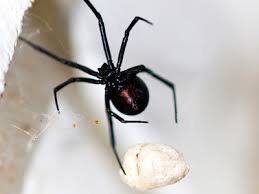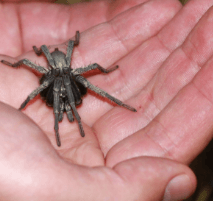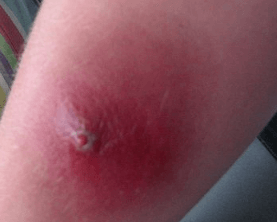What Is Wolf Spider Bite?
A wolf spider bite is considered very dangerous and very painful and are robust, agile hunters and they have excellent high sight. They are fast and relatively large in size. The wolf spiders have a reputation of being vicious predators and are normal mistaken for tarantulas
Wolf spiders are never seen at home except on winters and the autumn when they are seeking warm shelter. These spiders are very active hunters and do not need to spin webs so as to hunt or catch a prey.
Wolf spider bites mostly happen due to people’s ignorance and fear on the part of the spider. A wolf spider does not go out to bite people but it only bites without hesitation when it feels threatened or afraid.

How a Wolf spider Bite Looks like?
After one is bitten, fang marks and tearing of the skin can be present area especially if it is caused by a large wolf spider. Redness and swelling can also be present in that area. Indications of a wolf bite includes;
- Pain on the bitten area that can last up to fifteen days.
- Swelling on the surrounding skin parts.
- Swelling of the lymph glands.
- Darkening of the skin color around the bitten spot.
A bite from this spider is venomous but is not considered to be very fatal comparing to some other spider bites such as black widow or brown reclose spider bites that bring big damage and harm to people.
In other cases, to prevent the wound from being infected, proper care and treatment should be implemented immediately when the bite is discovered.
Identification
To identify a wolf spider bite, it is very crucial to know how a wolf spider looks like. The prominent and feature and characteristic to apply when identifying a wolf spider is to define the arrangement of the eyes.
- A wolf spider has eight eyes that are arranged in three rows. There are four small ones on the bottom row, two very large and prominent eyes on the middle row and two medium ones that are located on top of the head.
- The two biggest eyes usually grow very much when it is dark. A female wolf spider usually carry its eggs or even the baby wolf spiders on its back.
- A wolf spider bite is very painful and can cause a traumatic experience for the one affected. The bite appears scarier that it really is. One should not disturb a wolf spider so as to avoid being bitten.
- Although a wolf spider bite is not as dangerous as the black widow spider bite, it is necessary to understand a wolf spider bite and how it can be treated without causing more damage. This helps one to be prepared in case of any event of a wolf spider bite.
- A wolf spider bite is very painful though not dangerous. It is usually identifiable by two tiny red dots on where the bite has happened.
To prevent itching the affected person should rub toothpaste or baking soda to prevent swelling.
Symptoms
When a wound from a wolf spider bite is fresh, it has the following symptoms:
- It is very painful
- The wound start swelling and becomes very itchy
- It causes reddening of the skin on the bitten area.

After a few days of swelling, the wound causes swelling on the bitten spot, the skin around the bite start turning red, swelling of the lymph glands and it becomes very uncomfortable.
In some cases, when one experiences an allergic reaction from the bite, it can lead to:
- Itchiness of the skin.
- Nausea.
- Dizziness.
- Rapid pulse rate.
How to Get rid of a Wolf Spider?
Wolf spiders are ground dwelling hunters that usually hide in the dark corners and shadows. If one want to do away with wolf spiders either at work or at home the following processes can be carried out.
Changing the outdoor environment: Cleaning the outdoor environment involves the following procedures:
- Getting rid of yard of clutter and debris. This involves clearing away all piles of grass, firewood and any compost. Dark places usually attract pests so by exposing the yard to sunlight, it helps create an unappealing environment for spiders.
- Clearing vegetation around the house. Clearing all the shrubs and other plants draw away the wolf spiders since they no longer have dark places to hide.
- Seal all the cracks and holes in the outer wall. Sealing in all the holes and cracks in the outer wall prevents wolf spiders from sneaking in. Add some weather stripping to the doors and windows to minimize any risk of wolf spiders sneaking in.
- Install insect screens. Fix the fine mesh screen in all the vents leading to the yard.
- Remove all outdoor lighting. Light on the outside attracts insects thus providing food source for the wolf spiders. Therefore keep the outside lights turned off, the blinds drawn and the shades closed so as to minimize the number of insects drawn to the house.
Change the indoor environment: Changing the indoor environment reduces the number of wolf spiders hence reducing any events of wolf spider bites.
- Vacuuming the yard regularly. Sweep or vacuum the floor regularly getting rid of all the dirt that can attract insects. Insects attracts wolf spiders therefore, the lower the number of insects the lower the number of wolf spiders. Pay attention to areas with spider webs and get rid of them.
- Get rid of cardboard boxes. Get rid of all boxes that are made of cardboard and retain those that are made of plastic.
- Fill in the gaps. Use caulk to fix tiny gaps that lead to the outside. These gaps may not be visible from the outside therefore one should pay extra attention to the walls.
Treatment
One should be careful and cautious when dealing with any spider bites especially if you are not aware what type of spider has bitten you.
Things to do when bitten by a wolf spider include;
- Treat the swelling by placing a cool wet towel cloth over the bite. The coldness prevents the venom from spreading.
- Wash the wound with an antibacterial soap and warm water to prevent any infection.
- Elevate the wound and keep the area still to reduce swelling.
- Acetaminophen can be taken to reduce pain.
- If the wound begin to spread, you should see a doctor.
A wolf spider bite is not very dangerous but in case of severe reaction, medical attention is required immediately.
Pictures



Reference List
- How to Get Rid Of Wolf Spiders: Available at http://www.commonpests.com/how-to-get-rid-of-wolf-spiders
- Identification and Treatments of a Wolf Spider Bite: Available at https://healdove.com/first-aid/wolf-spider-bite
- Best Ways to Get Rid of Wolf Spiders: Available at http://www.getridofthings.com/pests/spiders/get-rid-of-wolf-spiders/
- Wolf spider Bite: Identification and Treatment Guide: Available at http://spiderbites.net/wolf-spider-bite/
- The Wolf Spider: How Dangerous Is its Bite? Available at https://www.thespruce.com/how-dangerous-is-wolf-spider-2656502
